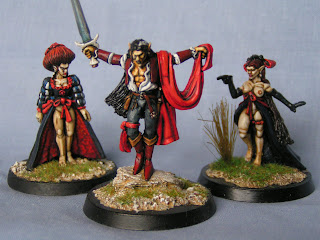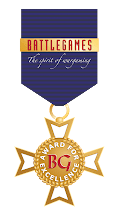Photo One - shows a Chuthlu style alphabet which was used as the source of the runes. The eight panels spell - TONY & SUE (My wifes name is Sue, I know I'm just a romantic!)
 Photo Two - shows the lit monolith, T and S showing.
Photo Two - shows the lit monolith, T and S showing.I've been modelling, painting miniatures and wargaming since I was a wee lad in Swansea, this blog details some of my interests - I hope that you like it. In 2010 I started a new modelling venture - building 40mm AWI/ACW terrain pieces and designing 28mm masters, which are then cast and available for sale from Grand Manner. - All original images and text are copyright of A. S. Harwood (Dampfpanzerwagon) - I can confirm that I do not hold any personal data on customers or followers of this Blog
 Photo Two - shows the lit monolith, T and S showing.
Photo Two - shows the lit monolith, T and S showing.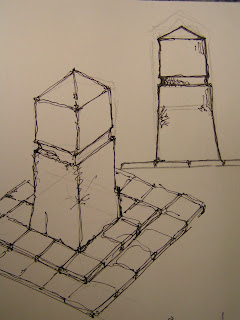 Photo One - shows the final designs sketch for the monolith shape and how it will fit onto the shrine. The basic shape owes a lot to illustrations in the Privateer Press magazines No Quarter.
Photo One - shows the final designs sketch for the monolith shape and how it will fit onto the shrine. The basic shape owes a lot to illustrations in the Privateer Press magazines No Quarter.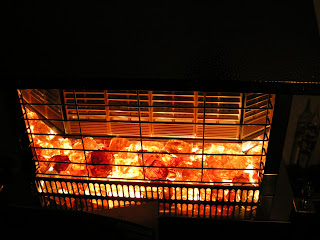 Photo Three - I have included this illustration of a gas fire to give an idea of the finish I was looking for.
Photo Three - I have included this illustration of a gas fire to give an idea of the finish I was looking for.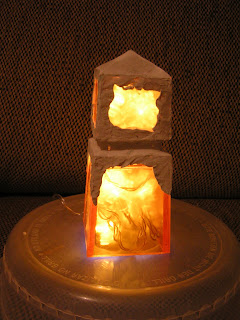 Photo Four - the latest illustration of work-in-progress, with the top of the monolith constructed from plastic card covered in DAS. I have still not decided on the final designs of the runes or icons and have been searching the Internet for some inspiration.
Photo Four - the latest illustration of work-in-progress, with the top of the monolith constructed from plastic card covered in DAS. I have still not decided on the final designs of the runes or icons and have been searching the Internet for some inspiration.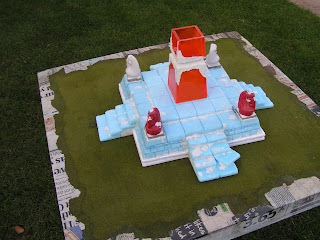 Photo One - shows the tile, stone base and Perspex monolith in natural light.
Photo One - shows the tile, stone base and Perspex monolith in natural light. Photo Two - shows the Perspex monolith and a set of 15 LED, battery operated 'snow drop' lights bought from British Home Stores for £3.00.
Photo Two - shows the Perspex monolith and a set of 15 LED, battery operated 'snow drop' lights bought from British Home Stores for £3.00. Photo One - the foam tile with edges sealed.
Photo One - the foam tile with edges sealed. Photo Two - shows the 5mm thick clear-tinted Perspex (still with protective paper film and held together, temporarily with sellotape). Note; the additional step/layer on the top of the pyramid or Zigarat added yesterday and detailed with DAS modelling clay.
Photo Two - shows the 5mm thick clear-tinted Perspex (still with protective paper film and held together, temporarily with sellotape). Note; the additional step/layer on the top of the pyramid or Zigarat added yesterday and detailed with DAS modelling clay. Photo Three - shows the Perspex monolith glued together with superglue and mounted on to the top of the shrine. I have started to add DAS modelling clay to the sides. My intention is to add a light or light effects into the tinted monolith with small icons carved into the DAS and back to the orange tinted acrylic sheet panels, hopefully giving an effect of glowing runes on a solid stone monolith!
Photo Three - shows the Perspex monolith glued together with superglue and mounted on to the top of the shrine. I have started to add DAS modelling clay to the sides. My intention is to add a light or light effects into the tinted monolith with small icons carved into the DAS and back to the orange tinted acrylic sheet panels, hopefully giving an effect of glowing runes on a solid stone monolith!





Tony
 Photo One - shows the blue foam pieces loosely stacked on top of one another - I use small off-cuts from a 30mm thick sheet, sliced in to 10mm layers and sanded smooth.
Photo One - shows the blue foam pieces loosely stacked on top of one another - I use small off-cuts from a 30mm thick sheet, sliced in to 10mm layers and sanded smooth. Photo Two - shows the sections glued together (with PVA glue) and the first set of carving, which is carried out with a new blade in a Swan Morton scalpel. I have also started to 'round' the edges with a sanding stick. The small holes are where I have used dressmakers pins to hold the foam together while the glue sets. In some construction articles these pins are removed once the glue has set - I leave them in place.
Photo Two - shows the sections glued together (with PVA glue) and the first set of carving, which is carried out with a new blade in a Swan Morton scalpel. I have also started to 'round' the edges with a sanding stick. The small holes are where I have used dressmakers pins to hold the foam together while the glue sets. In some construction articles these pins are removed once the glue has set - I leave them in place.
 Tony
Tony
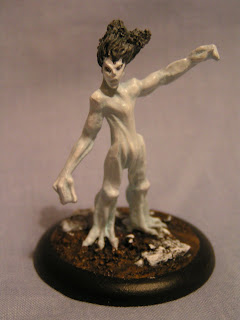 I am pleased with the result, but feel the colour scheme is still a little too pale and 'washed-out'. This being the smallest figure in the group of four, has been painted much paler than the other three will be. I am still to decide if this finish is right.
I am pleased with the result, but feel the colour scheme is still a little too pale and 'washed-out'. This being the smallest figure in the group of four, has been painted much paler than the other three will be. I am still to decide if this finish is right. Each miniature is 45mm long and mounted on a 40mm round base with the clear section from a Games Workshop flying base. A very easy conversion and group of model to add to the Flash collection - thank you Rhoderik.
Each miniature is 45mm long and mounted on a 40mm round base with the clear section from a Games Workshop flying base. A very easy conversion and group of model to add to the Flash collection - thank you Rhoderik. 
 Using a Testors Salt Flats Racer as the base, the main body was quickly put together. The miniature Flash is from Graven Images, a converted Nazi soldier.
Using a Testors Salt Flats Racer as the base, the main body was quickly put together. The miniature Flash is from Graven Images, a converted Nazi soldier.
I am happy with the finished model, but am not sure how I will use it in my own skirmish games.
Tony
In greater detail;
The design is based on the 'skimmer' used in the Queen - Flash Gordon film. I tried to model the hull as the film version, but found the many angles too difficult to reproduce. I already had a Salt Flats Racer model from the American producer Testors and thought that this would make a great base for a more curved skimmer.
The body of the racer was first glued to a base, then a section from the centre removed and the two hull pieces glues back together. Similarly a section was then removed from the middle section and the two pieces glued together and a base added. The curved hull was then built up with scrap plastic and covered with two part epoxy and sanded smooth. This took some time and a lot of sanding/smoothing/filling/sanding etc. etc.
The control column was layers of plastic card glued together and sanded smooth. The wings are from the Airfix Robotwars boxed set and the small rockets on the wind roots are sanded bombs from my spares box. There is also a rocket body under the main sled, which also came from my spares box, additional detail are sections of plastic card/plastic rod and bits.
The figure is from Graven Images - much re-modelled and converted.
Painting was done with acrylics and washed with Games Workshop washes and watered down inks.
 http://stores.ebay.co.uk/THE-GROH-GALLERY-OF-AVIATION-ART
http://stores.ebay.co.uk/THE-GROH-GALLERY-OF-AVIATION-ART
 Tony
Tony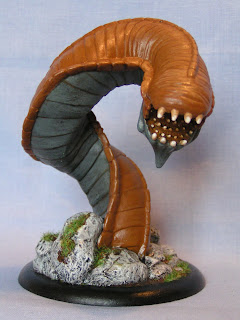 The rock base needed some modelling with Milliput and fine sand. The body of the worm, also had considerable re-modelling to hide some of the very prominent mould lines and various joints.
The rock base needed some modelling with Milliput and fine sand. The body of the worm, also had considerable re-modelling to hide some of the very prominent mould lines and various joints.
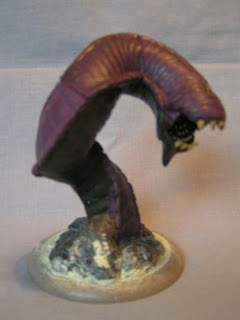 The final two photos, show work-in-progress shots which highlight some of the detailing prior to painting and having the base colours added.
The final two photos, show work-in-progress shots which highlight some of the detailing prior to painting and having the base colours added.Tony
 The miniature was picked up from the bargain basket at Waylands Forge, Birmingham and based on a 50mm round base. The miniature stands 60mm tall and was painted red as I already had a dark brown and white 'hairy monster'. The miniature is modified, having the axe cut from the right hand, the right hand and right knee re-modelled with 'green stuff' prior to being painted with acrylic paints over a black basecoat.
The miniature was picked up from the bargain basket at Waylands Forge, Birmingham and based on a 50mm round base. The miniature stands 60mm tall and was painted red as I already had a dark brown and white 'hairy monster'. The miniature is modified, having the axe cut from the right hand, the right hand and right knee re-modelled with 'green stuff' prior to being painted with acrylic paints over a black basecoat.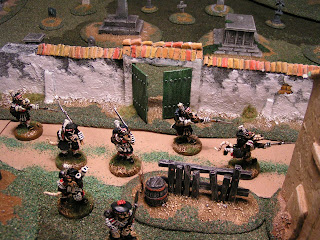 Most of the troops are obvious, however please note that there is an Orc officer in the foreground. The buildings and wall are scratch built, the road is simple sandpaper, the piece of fence is built from toffee apple sticks and all of the grave stones are scratch built (the first time they have all appeared on film).
Most of the troops are obvious, however please note that there is an Orc officer in the foreground. The buildings and wall are scratch built, the road is simple sandpaper, the piece of fence is built from toffee apple sticks and all of the grave stones are scratch built (the first time they have all appeared on film). I have composed a number of shots to illustrate the first scenario - A most vital matter, where a group of seamstresses are left to fall behind the main Orc column and are now about to be attacked by a group of Spanish guerrillas.
I have composed a number of shots to illustrate the first scenario - A most vital matter, where a group of seamstresses are left to fall behind the main Orc column and are now about to be attacked by a group of Spanish guerrillas.
 Tony
Tony

 The third photo, prior to painting shows the construction. A pair of biro pens, glued end-to-end, plastic card superstructure and tail, knitting needle turrets and detail from my 'spares box'. Painting was done with various acrylic paints and a Games Workshop wash, with detail picked out by brush. The flag (hidden in both photos) and tail was hand painted and the 'Grim Reaper' transfer was from a French WW1 airplane transfer sheet.
The third photo, prior to painting shows the construction. A pair of biro pens, glued end-to-end, plastic card superstructure and tail, knitting needle turrets and detail from my 'spares box'. Painting was done with various acrylic paints and a Games Workshop wash, with detail picked out by brush. The flag (hidden in both photos) and tail was hand painted and the 'Grim Reaper' transfer was from a French WW1 airplane transfer sheet.